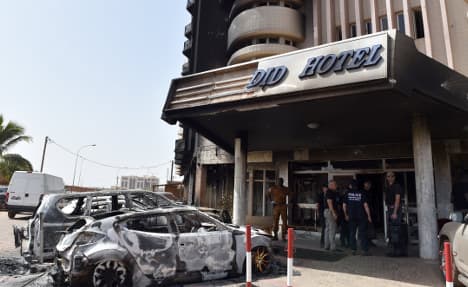Nine-year-old Italian boy killed in Burkina Faso attack

A nine-year-old Italian boy was among the 28 people killed when extremists attacked a hotel and café in Burkina Faso on Friday, according to Italian media reports.
Misha Santomenna was reportedly among the 28 people killed in the siege at the Splendid Hotel and nearby Cappuccino café in the west African country’s capital of Ouagadougou, Corriere reported.
Italy’s foreign ministry said on Sunday that the boy was inside the café, along with his mother, when the attack by al Qaida-linked extremists happened.
The ministry added that it is trying to learn the fate of the boy.
His mother, of Ukrainian origin, is also believed to be among the victims. Victoria Yankovska had co-owned the cafe with her husband, Gaetano Santomenna, since 2012. Yankovska’s sister is also reported to have died.
Authorities in Burkina Faso are carrying out formal identification of the victims, a process which could take some time because of the number of those killed and of different nationalities, the ministry said.
Among those confirmed dead include two French, two Swiss, six Canadians and one each from the US, Holland, Portugal and Libya.
Comments
See Also
Misha Santomenna was reportedly among the 28 people killed in the siege at the Splendid Hotel and nearby Cappuccino café in the west African country’s capital of Ouagadougou, Corriere reported.
Italy’s foreign ministry said on Sunday that the boy was inside the café, along with his mother, when the attack by al Qaida-linked extremists happened.
The ministry added that it is trying to learn the fate of the boy.
His mother, of Ukrainian origin, is also believed to be among the victims. Victoria Yankovska had co-owned the cafe with her husband, Gaetano Santomenna, since 2012. Yankovska’s sister is also reported to have died.
Authorities in Burkina Faso are carrying out formal identification of the victims, a process which could take some time because of the number of those killed and of different nationalities, the ministry said.
Among those confirmed dead include two French, two Swiss, six Canadians and one each from the US, Holland, Portugal and Libya.
Join the conversation in our comments section below. Share your own views and experience and if you have a question or suggestion for our journalists then email us at [email protected].
Please keep comments civil, constructive and on topic – and make sure to read our terms of use before getting involved.
Please log in here to leave a comment.